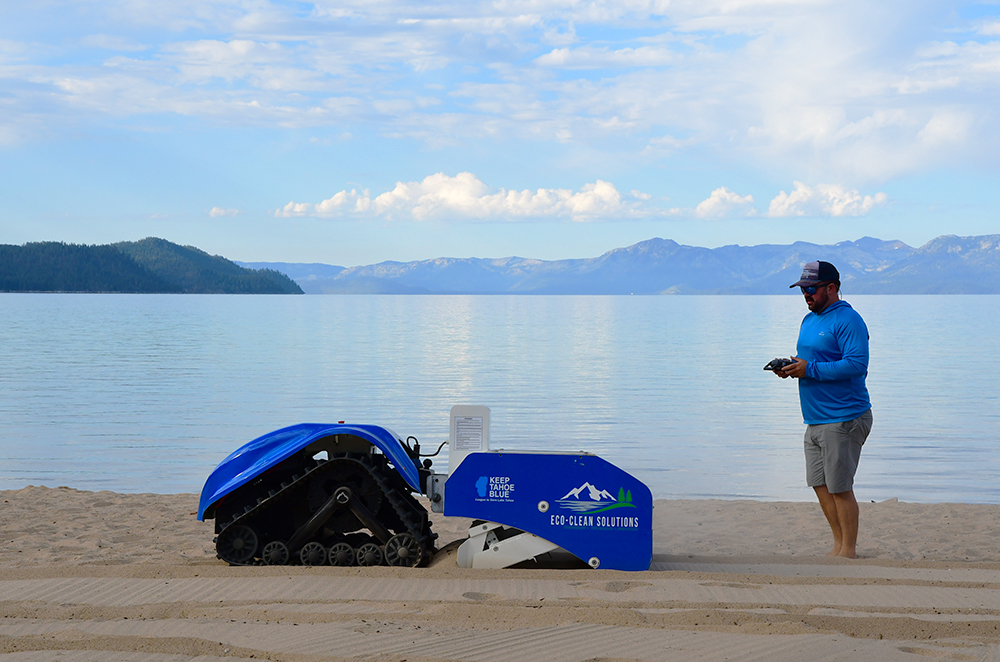
LAKE TAHOE, CA/NV (October 19, 2022) – Amidst the coolers, umbrellas and towels, there was an unfamiliar sight on Lake Tahoe’s beaches this summer – a blue, picnic table-sized machine outfitted with tank treads and solar panels, quietly sifting tiny pieces of trash out of the sand.
Tahoe’s beaches represent the last stop for small pieces of litter before they enter the lake’s vibrant blue waters, where they’re all but impossible to remove. The all-electric, remote-controlled, beach-cleaning robot, or BEBOT, was deployed around the Tahoe Basin for the first time in 2022. The Tahoe debut was also the first time the technology has been used on the West Coast.
The robot was brought to the country’s most popular alpine lake through a collaboration between ECO-CLEAN Solutions and the League to Save Lake Tahoe, the 65-year-old nonprofit behind the “Keep Tahoe Blue” environmental movement. In its first summer of action, the BEBOT was tested to see how efficiently and effectively it can remove hard-to-find, hard-to-remove trash, and to determine what role it can play in fighting litter at the lake.
“To most people, Tahoe’s beaches look perfect, but there’s a mess hidden in those first few inches of sand,” said Jesse Patterson, the League to Save Lake Tahoe’s chief strategy officer. “New technology like the beach-cleaning robot, along with science, volunteerism and partnerships, are all needed for a litter-free Lake Tahoe.”
Between June and October, the BEBOT visited 11 beaches around the Tahoe Basin managed by the USDA Forest Service, California State Parks, Nevada State Parks, local governments and private owners. Each visit was permitted and preceded by a site survey for the endangered Tahoe Yellow Cress plant. The effort identified several new populations of the endemic species and ensured sensitive habitat was avoided. At each cleanup site, the robot covered up to a 5,000 square foot area, methodically sifting sand up to four inches deep and gathering small bits of garbage and organic matter in its hopper.
“Shared stewardship of public lands by agencies, private sector business, nonprofits, and most importantly the public is key to protecting the Tahoe environment and experience,” noted Daniel Cressy, public services staff officer for the USDA Forest Service Lake Tahoe Basin Management Unit. “Innovative approaches, such as utilization of the BEBOT, help push the boundary of the ways we care for the land and what we imagine is possible.”
To illustrate the robot’s effectiveness, volunteers removed all the litter they could before the BEBOT was deployed at nearly every site. Even after pre-cleaning, the robot gathered a staggering amount of hidden litter – 6,315 pieces in total. That included 2,085 assorted pieces of plastic, 325 cigarette butts and 1,695 bits of organic waste (such as pistachio shells, cherry pits and orange peels) that can take years to biodegrade. These figures show that litter may be out of sight and out of mind, but it certainly isn’t out of the environment.
One site, Nevada Beach, was visited twice this year: on July 5th as part of the League’s annual Keep Tahoe Red, White and Blue beach cleanup, and again on October 4th. The total litter removed on each day – 596 pieces in July and 503 pieces in October – are strikingly similar, showing that litter accumulates very quickly and can easily get buried in the sand where it’s hidden from traditional cleanup efforts.
Among the 11 sites visited, Zephyr Shoals, an unmaintained stretch of beach on the east shore, contained the most trash. That mirrors results from a League cleanup earlier in the summer, where a team of volunteers removed 2,700 pounds of litter in a single morning.
The new technology supports, but doesn’t replace, other ways of fighting litter. Next year the BEBOT will work in tandem with Tahoe Blue Crews, one of the League’s volunteer programs where individuals and groups adopt sites for regular cleaning and litter data collection. This year, the BEBOT constituted its own Tahoe Blue Crew.
The BEBOT’s performance in its 2022 pilot season shows it can serve as the last line of defense to keep pollution, including ubiquitous and persistent plastic trash, out of the water. Keeping Tahoe’s beaches litter-free will require an ongoing effort, including sufficient trash cans and dumpsters, maintenance staff, volunteer events, informed and motivated beach-goers, and innovative technology like the BEBOT.
“Unfortunately, there is no silver bullet that is going to remove all the trash from the shores of Lake Tahoe,” said ECO-CLEAN Solutions’ Founder and CEO JB Harris. “But the introduction of the BEBOT is a huge step in the right direction.”
Looking ahead to next summer, the League and ECO-CLEAN Solutions are working with public and private land managers to schedule regular BEBOT cleanups for the spring and fall, expand cleaning areas to cover entire beaches, and use the data collected to devise policy solutions to stop trash before it becomes litter. The partners are also exploring a range of other opportunities, such as targeting invasive Asian clam shells and goose droppings as a nuisance and water quality threat, and introducing other innovative cleaning technologies in 2023.
The BEBOT is manufactured by The Searial Cleaners.
###
Media resources: Video & images, more about the BEBOT
Media contact:
League to Save Lake Tahoe, Chris Joseph, 805.722.5646
The League to Save Lake Tahoe, also known by its iconic slogan “Keep Tahoe Blue,” is Tahoe’s oldest, largest and most successful nonprofit environmental advocacy organization. Our team of solutions-oriented Tahoe advocates use innovation, boots-on-the-ground action, and a holistic approach to solve the environmental challenges threatening the lake we love. In our 65th year, we continue pushing to Keep Tahoe Blue in an ever-changing world. Learn more at keeptahoeblue.org and @keeptahoeblue.


